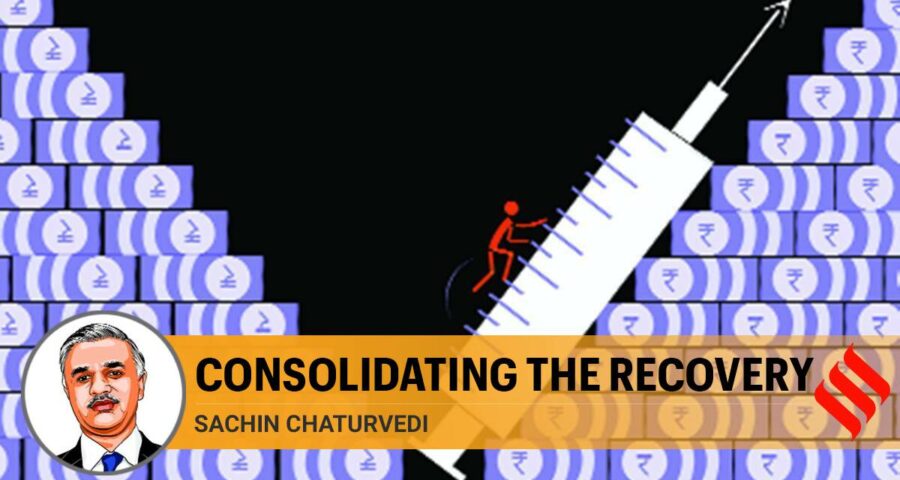This year, as the Economic Survey shows, the focus is predominantly on the recovery path after initial derailment and the losses suffered by the Indian economy due to the pandemic. The recovery is expected to follow a V-shaped path.
Finance Minister Nirmala Sitharaman tabled the Economic Survey 2020-21 in Parliament on Friday, focussing on the basic tenets of development — Atmanirbhar Bharat in Covid times, going beyond “nudging”, shifting from entitlement-based approaches to an entrepreneurship-based policy framework. The Survey also revisits some of the fundamental issues that lopsided development strategies have posed for India and other developing countries such as growth and inequality, and debt sustainability.
Last year, the Economic Survey focussed wealth creation, promotion of pro-business policies and strengthening of trust in the economy. This time, the focus is very much on the efforts to “find its way from the darkness of lives vs livelihoods to the glow of saving lives and livelihoods.” Digitalisation and technology have occupied an important place in both parts of the Survey.
As it happens, the Economic Survey analyses the broad trends at the macro level and the profiling of the initiatives across various economic activities like infrastructure, agriculture, industrial production, employment, prices, exports, imports, foreign exchange reserves as well as in social sectors like health, education, etc. This year, as the document shows, the focus is predominantly on the recovery path after initial derailment and the losses suffered by the Indian economy due to the pandemic. The recovery is expected to follow a V-shaped path. There is also the evident rush for making India a $5-trillion economy by 2024. The Survey brings together various relevant factors that have both a short and long-term impact on the economy and the budget.
The Survey advocates countercyclical fiscal policies based on the premise that growth leads to debt sustainability, the implications of which augur well for raising additional resources for welfare spending. This also takes into account that India’s foreign exchange reserves are sufficient to take care of India’s cumulative public and private debt. In such matters, assessments by credit rating agencies are fundamentally flawed, considering India’s strong credentials on both the willingness and the ability to repay loans.
If we consider the last two Economic Surveys, the introduction of new concepts and approaches has been quite evident. For instance, in the Survey for 2018-19, the idea of “nudge” helped provide recognition of the importance of social behaviour change for any policy to succeed. We have noticed the power of articulation and persuasion coming from the highest political office of the country. This has been evident in the transformative approach adopted in the Swachh Bharat Mission and Beti Bachao Beti Padhao initiative that integrated behavioural insights. Another powerful idea has been using technology to run and monitor welfare schemes. This was prompted by the success of the MGNREGA that leveraged the full potential of the JAM trinity. Keeping in view the future slowdown in the demographic dividend and progressive shift towards an ageing society in some states, the Survey made some valuable recommendations towards schooling, public expenditure on healthcare and raising the retirement age.
This year’s Survey focuses on enhanced public healthcare spending and demonstrates how effective it has been in slashing out-of-pocket expenditures in the recent past. It also shows the brilliant performance under the Pradhan Mantri Jan Arogya Yojana (PM-JAY) and the improved outcomes in states that have implemented the programme. Health sector outcomes have also received a strong boost from improvements in basic parameters like water and sanitation, housing, micro environment and other facilities. With focus on basic needs, the Survey has brought back national attention on the fundamental developmental paradigm. The idea of analysing inequalities in times of recovery is a reassuring premise to move on with.
The Economic Survey 2019-20 talked overwhelmingly about the importance of wealth creation, entrepreneurship, and financial markets in the economic development and aspirations of the country, and discussed in detail the facilitating role of the government. The Survey took recourse to India’s economic history to suggest that it has never been antithetical to ethical wealth creation and invoked texts such as Kautilya’s Arthashastra and Thiruvalluvar’s Thirukkural.
The multi-sectoral National Infrastructure Pipeline (NIP) scheme is a major initiative to boost inclusive economic growth and employment opportunities in the country, with a total outlay of Rs 111 lakh crore expected to be spent during 2020-25 in diverse infrastructure projects in sectors, including energy, roads, urban infrastructure and railways. These projects would go a long way in invigorating India’s competitiveness in the world economy.
The Survey should have focussed on a new narrative for trade. Apart from explaining the missing value chains and integration with South and Southeast Asia, the survey should have analysed the high cost of tariffs when 38 per cent of our exports are import-dependent. The impact of COVID-19 on the global economy was exceptionally sharp and developing countries, including India, faced less of it due to prudent domestic trade policies. India relaxed its commercial policies in the post-lockdown period to allow the external sector to grow. The upturn in the merchandise exports became much stronger than in imports. Besides trade, FDI inflows and the accumulation of foreign exchange reserves has been remarkable this year. It is expected that India will emerge as an important link in the global value chain sector which has been visibly disrupted by the pandemic.
The Economic Survey has set the stage for promoting local production and consumption, exploring resilience and internal strengths. The inspiration for a thorough Indian approach in policymaking has obviously been nurtured and guided by the political leadership — the most recent manifestation has been in the form of Atmanirbhar Bharat.
This article first appeared in the print edition on January 30, 2021 under the title ‘Consolidating the recovery’. The writer is director-general, Research and Information Systems for Developing Countries. Views are personal.
Source: Read Full Article


